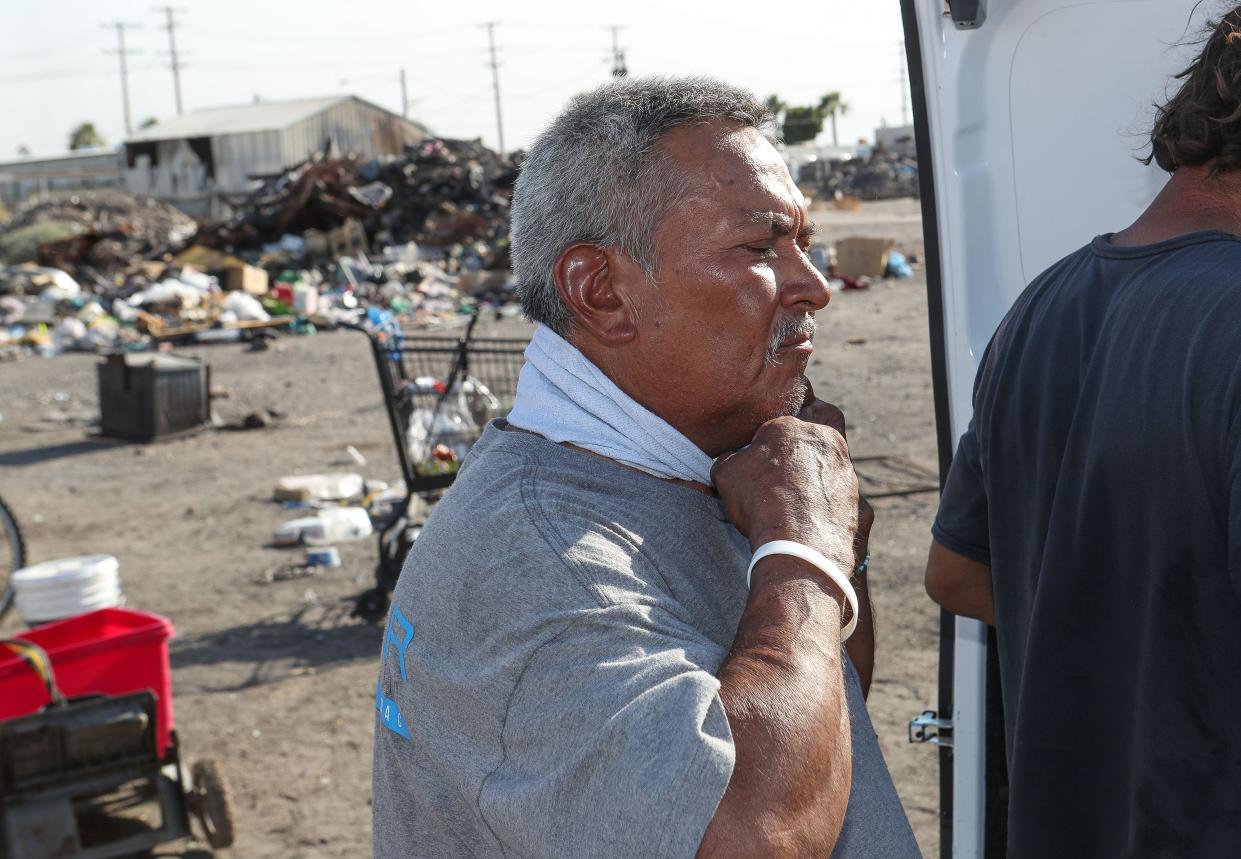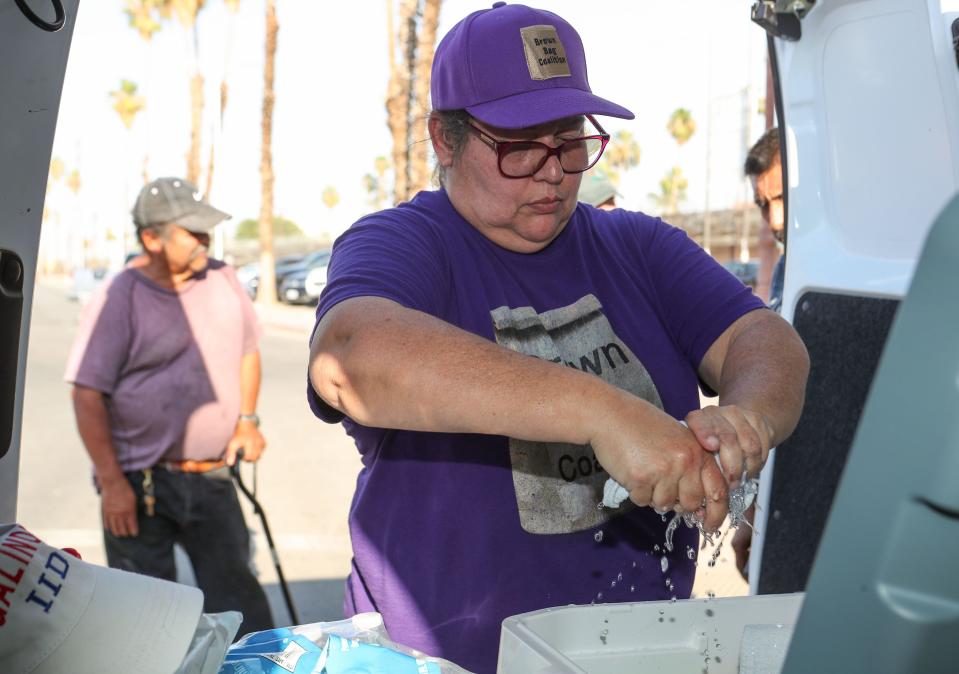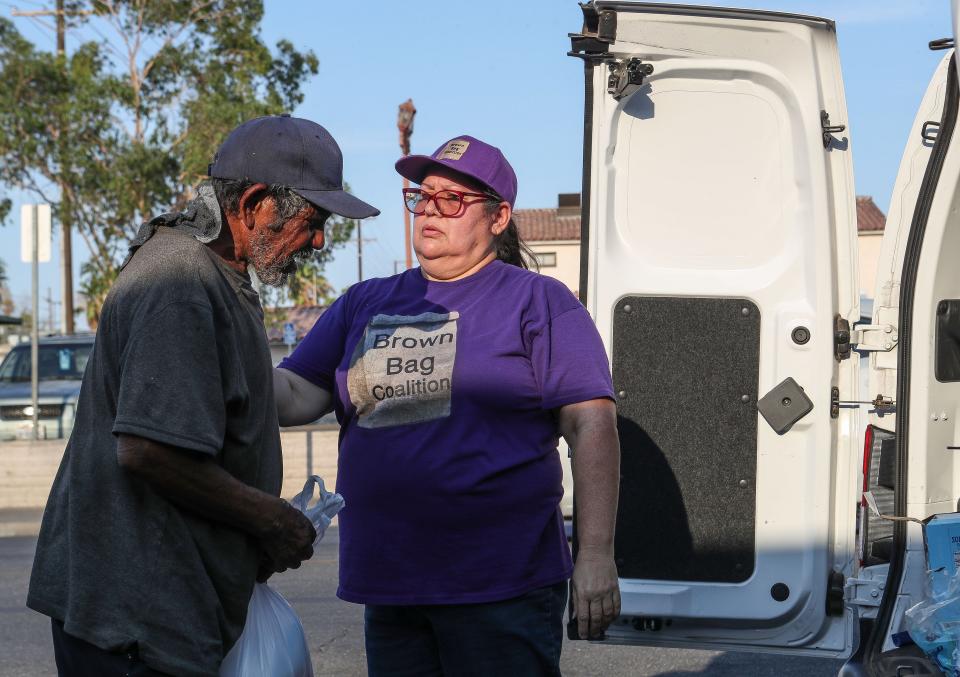In California’s hottest county, a race to prevent heat deaths among unhoused people

When the forecasted temperature in Imperial County hits 113 degrees or higher, Maribel Padilla loads up her van with water bottles and a cooler full of ice pops and cold washcloths and hits the road, stopping at encampments and downtown areas in Calexico and El Centro to drop off supplies to people who are homeless in the region who need a way to cool down.
Padilla founded Brown Bag Coalition, a grassroots nonprofit group serving the homeless population in the region, following a historic freeze event in 2014. These days, she’s mostly occupied trying to keep people safe from the opposite problem ― rising summer temperatures that are increasingly pushing the extremes of what the human body can handle.
On Wednesday, she started loading up her van a little after 4:30 p.m., after her full-time job as a community organizer for Imperial Valley with Planned Parenthood, and pulls back into a parking and storage area she rents out next to her husband’s TV repair business about two hours later. She’ll be doing that routine a lot more often this month, with temperatures forecasted to reach 113 or above in El Centro at least through next Thursday, with a peak forecast of 117 degrees this Saturday and Sunday.
There wasn’t a specific reason why Padilla chose 113 degrees as the cut-off temperature ― she has limited time and resources and needed to draw a line somewhere because she can’t go out daily. While 111 and 112 degrees felt more common during scorching summers in the southeastern corner of California, 113 felt relatively rare enough that it represented a seriously hot day for Imperial County.
This month, it feels less rare.
“I looked at the weather app and went, ‘Oh shit, it’s the entire week.’ Before it was usually only one or two days of the week, but right now it’s like every day. Every year it’s getting worse,” said Padilla.

The high temperatures hitting Imperial County and the Coachella Valley this month are part of an extended heat wave scorching the Southwest, driven by an area of high pressure settling over the region. The heat wave is notable for both its temperature and duration, with days on end forecasted at temperatures above 113 degrees in Imperial County. The California deserts region, spanning Riverside, San Bernardino, and Imperial counties, is under an excessive heat warning from July 12 through July 18, along with most of the rest of the state and broad swaths of Arizona and Nevada.
Excessive heat warnings have proven deadly in Imperial County in past years. From April through early October of last year, a time period marked by seven excessive heat warnings, a total of 27 confirmed or probable deaths from heat-related causes were reported in the county, up from 23 deaths in 2021 and five in 2019.
Nearly half of the deaths were among the county’s homeless population, which numbered 1,303 in the 2023 point-in-time count.
“I don’t think people realize how when a person dies of heat stroke, it’s not an easy death. People think ‘Oh it was hot,’ no it’s painful, his body was cramping, he was convulsing and foaming at the mouth. Nobody deserves to die like that,” said Diahna Garcia-Ruiz, whose brother, Martin Vargas, died from heat stroke while homeless in El Centro last August.
Imperial County has always been hot. The county experiences more days above 100 degrees than anywhere else in California or the West. But climate change is driving up temperatures to even further extremes, creating health threats, especially for people who are unsheltered or work outdoors in the heat of the day.
“We try to just shower and shower and shower to try to keep our minds okay, because this heat is crazy. Even with just walking a couple of blocks you start to feel bad,” said Martin Castro, who grabbed a cold wash cloth and water from Padilla at one of her stops in Calexico on Wednesday.
Imperial County also has a high rate of unsheltered homelessness. In 2022, roughly 88% of the county’s homeless population were unsheltered, meaning they slept outdoors, in vehicles, or in other places not meant for human habitation, rather than in shelter beds. According to the U.S. Department of Housing and Urban Development, this percentage means Imperial County has a higher rate of unsheltered homelessness than any other suburban county in the U.S.

Paula Llanas, director of Imperial County’s Department of Social Services, says this data comes with a caveat: residents of Slab City, the longstanding off-grid community known as “the last free place,” started being counted as part of the annual homeless count in 2017, and many Slab City residents meet the definition of unsheltered homelessness by living in places not meant for human habitation. In the most recent point-in-time count conducted in January, Imperial County counted 157 people staying in emergency shelters or transitional housing, and 1,146 unsheltered individuals. A total of 433 of those unsheltered individuals, or 38%, were in Slab City.
By noon on Wednesday, the thermometer read 109 degrees in El Centro, and 52 people had signed in at a new modular air-conditioned building behind the Catholic Charities Diocese of San Diego’s Imperial County office. The new Catholic Charities Day Center opened this May, just in time for summer, and since then the number of daily visitors has ticked upward along with rising temperatures, with up to 60 to 70 people on the hottest days. “For the longest time there was nothing like this around here,” said 61-year-old Jose Dilan, who grew up in Calexico and now visits the Day Center most days to eat, take a shower, and escape the heat.
There are several cool centers available in the county, but many are only open limited days or hours, often closing on weekends or holidays. Cool centers also are often libraries or community centers, and visiting those spaces can be complicated ― Garcia-Ruiz says her brother didn’t feel comfortable visiting local libraries to escape the heat because he felt like he drew negative attention from other visitors.
The Day Center is open seven days a week from 8:30 a.m. to 4:30 p.m., 365 days a year. In addition to a place to cool off, the center serves breakfast, lunch, and dinner, showers and laundry machines, and offers a variety of on-site services.
“In Imperial County, there wasn’t a single day center open for the unhoused. . . And the weather here fluctuates, it gets very hot and very cold,” said Vino Pajanor, CEO of the Catholic Charities Diocese of San Diego. “People need a place to go inside, first and foremost, to get a reprieve from the weather, but also a place where they can get some food when they’re hungry, where they can do their laundry and take a shower.”
The day center was made possible through over $2 million in state homelessness funds, which the county awarded to Catholic Charities. About 500 people have utilized the day center so far, a sizable portion of Imperial County’s homeless population. Staff at the day center work to match clients with shelter, usually through emergency housing vouchers. But there’s still a need for more shelter beds, Pajanor said.
“They’re here in the daytime, but then what happens to them? They go from our day center back into the street,” Pajanor said.
And as climate change drives up nighttime temperatures, evenings don’t offer much relief. At 6:30 p.m. on Wednesday, it was still 107 degrees in El Centro.
“When it’s this hot you don’t really sleep, you wake up dripping with sweat,” said Jeff Simpson, who has been homeless in El Centro for the past two years. Simpson tries to keep a wet towel on him “at all times” overnight, waking up repeatedly to get it wet again. “And this is just the beginning of summer weather for us.”
This article originally appeared on Palm Springs Desert Sun: Imperial County extreme heat: Unhoused people face health risks

